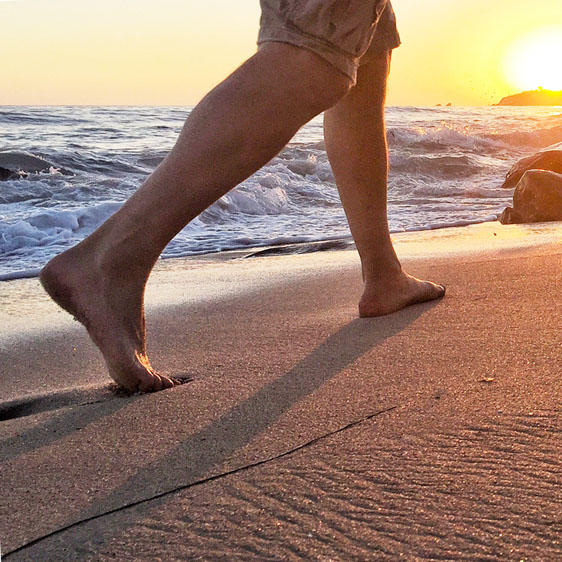
While walking around your neighborhood, you feel pain in your legs that seems to ease when you rest. You might tell yourself that it's just part of getting older — but that could be a mistake.
Your symptoms may signal a serious medical condition called peripheral arterial disease (PAD).
PAD occurs when cholesterol, fats and calcium deposits accumulate on the walls of arteries in the legs. This narrowing of the arteries, known as atherosclerosis, can take years to develop, so it is more common as people enter their 50s and 60s. Because it restricts blood flow to the lower body, it can make walking difficult, and having it raises a person's risk for heart attack and stroke.
If left untreated, PAD can become so severe that it may lead to gangrene and leg amputation.
What does PAD feel like?
The main symptom of PAD is a cramping pain or fatigue in the calf, thigh or hip muscles while walking, climbing stairs or doing other exercise. Stopping for a short rest usually relieves these symptoms. However, once you resume exercise, the discomfort returns.
In addition to leg pain during exercise, reduced blood flow in the legs, or claudication, may also:
- Cause leg or foot pain or a burning sensation that wakes you up at night
- Lead to sores on the legs or feet that are slow to heal
- Cause numbness or tingling in the legs
- Cause cold feet or extremities
However, most people with PAD don't have any symptoms at all. Among those who do have symptoms, many dismiss them as just a part of aging.
It's a good idea to discuss with your doctor any risk factors for PAD you may have and ask about getting tested for the disease, reports the National Heart, Lung, and Blood Institute. There is a simple test called the ankle-brachial index, or ABI, that diagnoses PAD by comparing the blood pressure in your ankles with the pressure in your arms.
Risk factors for PAD include:
- Being older than 50.
- Having a history of smoking.
- Having high blood pressure or high cholesterol.
- Having diabetes.
- Being African American.
- Having a personal or family history of heart attacks, strokes or other blood vessel conditions.
Reduce your risk.
 PAD is a major risk factor for heart attack and stroke. And it is especially dangerous for those who have diabetes or continue to smoke.
PAD is a major risk factor for heart attack and stroke. And it is especially dangerous for those who have diabetes or continue to smoke.
In practical terms, anything you do to reduce the risk of PAD will also help protect you from heart attack and stroke. For example, quitting smoking, getting regular exercise and eating a healthy diet low in fat and salt are usually recommended if you're at risk for cardiovascular disease or PAD, or if you have diabetes.
“The more you get out and move, the better your body is able to keep blood vessels open, enlarge the blood vessels that are open and allow them to carry more blood. It also enables the body to recruit enzymes in the muscles, which allows them to get more oxygen out of the blood,” said board-certified vascular surgeon, Chad Tober, MD. “And the end result is you can have incredible increase in function.”
Treatment options for PAD
- Lifestyle changes. Key steps include exercising; not smoking; and making heart-healthy food choices, such as eating less fat and cholesterol and more whole grains, fruits and vegetables.
- Medicines. Prescription medicines can help prevent blood clots, can lower cholesterol and can reduce pain while walking.
- Surgery. If PAD is severe, either angioplasty or bypass surgery may be needed to restore blood flow.
>Learn more about treating PAD or peripheral vascular disease.
Do you know if you're at risk for PAD?
Take this quiz to find out.
Many times a high score is a winning score. But not on this quiz. A high score means you're at greater risk for peripheral arterial disease (PAD). To find out your risk, select yes or no to answer each question.
YES / NO 1. Do you have high blood pressure, or have you had a heart attack or stroke?
YES / NO 2. Do you have diabetes?
YES / NO 3. Does someone in your immediate family (parent, sister, brother) have a history of diabetes or cardiovascular problems?
YES / NO 4. Do you feel aching, cramping or pain in your legs when you walk or exercise, but the pain goes away when you stop and rest?
YES / NO 5. Do you have pain in your toes or feet at night?
YES / NO 6. Are ulcers or sores on your feet or legs slow to heal?
YES / NO 7. Do you lead an inactive lifestyle?
YES / NO 8. Do you smoke?
YES / NO 9. Have you ever smoked?
YES / NO 10. Are you more than 25 pounds overweight?
YES / NO 11. Do you eat fried or fatty foods three times a week or more?
The more yes answers you have, the more important it is to see a doctor. He or she may recommend testing for PAD.
Quiz adapted with permission, Society of Interventional Radiology, Legs for Life®

